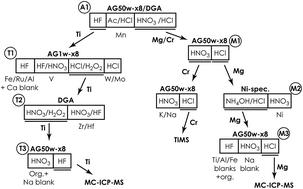当前位置:
X-MOL 学术
›
J. Anal. At. Spectrom.
›
论文详情
Our official English website, www.x-mol.net, welcomes your
feedback! (Note: you will need to create a separate account there.)
Multi-element ion-exchange chromatography and high-precision MC-ICP-MS isotope analysis of Mg and Ti from sub-mm-sized meteorite inclusions†
Journal of Analytical Atomic Spectrometry ( IF 3.1 ) Pub Date : 2018-03-15 00:00:00 , DOI: 10.1039/c7ja00392g K. K. Larsen 1, 2, 3, 4 , D. Wielandt 1, 2, 3, 4 , M. Bizzarro 1, 2, 3, 4
Journal of Analytical Atomic Spectrometry ( IF 3.1 ) Pub Date : 2018-03-15 00:00:00 , DOI: 10.1039/c7ja00392g K. K. Larsen 1, 2, 3, 4 , D. Wielandt 1, 2, 3, 4 , M. Bizzarro 1, 2, 3, 4
Affiliation

|
The analytical improvement of new generation mass spectrometers has reached a level required for high-precision isotope analysis of very small and unique natural samples. The multi-element isotopic signatures of meteorite inclusions can potentially provide detailed insight into the origin of our solar system. As such, in-line separation and isotope analysis of multiple elements from such unique samples is highly desirable, but rarely accommodated by current chromatographic purification procedures necessary for accurate isotope analysis using multiple collector inductively coupled plasma source mass spectrometry (MC-ICP-MS). Here, we report a new multi-element ion chromatographic purification procedure, specifically developed for the separation of very small amounts of Mg (∼5 μg) and Ti (0.7–1 μg) from individual samples. Highly isotopically anomalous sub-mm sized materials, such as Ca–Al-rich inclusions in primitive meteorites, can be routinely analysed for their mass-independent μ26Mg*, μ46Ti*, μ48Ti*, μ49Ti* and μ50Ti* isotope compositions with an estimated external reproducibility of 4.1, 11, 8.8, 18 and 12 ppm (2sd), respectively. These procedures consume significantly less material than previous methods and as such represents a 6- to 10-fold improvement in precision. The method ensures >99.9% Mg and >97% Ti recovery, thereby allowing for the accurate determination of mass-dependent compositions with a precision better than ∼60 ppm amu−1 for both Mg and Ti. It can further be adapted to accommodate the in-line separation of e.g. Ca, Cr, Fe, Ni, W, Mo, Ru, V, Zr and Hf from the same sample matrices. Doping tests on a synthetic Ti standard demonstrate that isobaric interference can be adequately corrected for provided that atomic ratios are Ca/Ti < 0.07, V/Ti < 0.04 and Cr/Ti < 0.005 and Zr2+, Mo2+ and Ru2+ have no influence on Ti measurements when atomic ratios are Zr/Ti < 0.002, Mo/Ti < 0.01 and Ru/Ti < 0.001, which is ensured by the chromatographic procedures. Magnesium and titanium isotope data for terrestrial geostandards and isotopically anomalous chondrite meteorites (OC, CR, CV, and CI) and two CV CAIs are in excellent agreement with literature values, demonstrating the accuracy of our methods. The two CAIs plot on an extension of the mass-independent correlation line between μ46Ti* and μ50Ti* defined by inner solar system materials, suggesting residual nucleosynthetic effects in CAI precursors.
中文翻译:

亚毫米大小陨石包裹体中Mg和Ti的多元素离子交换色谱法和高精度MC-ICP-MS同位素分析†
新一代质谱仪的分析改进已经达到了对非常小且独特的自然样品进行高精度同位素分析所需的水平。陨石包裹体的多元素同位素特征可能会为我们的太阳系起源提供详细的见识。因此,非常需要从此类独特样品中进行多种元素的在线分离和同位素分析,但很少使用使用多收集器电感耦合等离子体源质谱(MC-ICP-MS)进行精确同位素分析所必需的当前色谱纯化程序提供。在这里,我们报告了一种新的多元素离子色谱纯化程序,专门用于从单个样品中分离非常少量的Mg(〜5μg)和Ti(0.7-1μg)。26毫克*,μ 46的Ti *,μ 48的Ti *,μ 49的Ti *和μ 50分别的Ti *为4.1,11,8.8,18和12ppm的(2SD)的估计外部再现性同位素组合物,。这些程序比以前的方法消耗的材料少得多,因此,其精度提高了6到10倍。该方法可确保> 99.9%的Mg和> 97%的Ti回收率,从而可以精确测定质量相关的成分,而Mg和Ti的精确度均优于〜60 ppm amu -1。它可以进一步适应于在线分离,例如来自相同样品基质的Ca,Cr,Fe,Ni,W,Mo,Ru,V,Zr和Hf。如果原子比为Ca / Ti <0.07,V / Ti <0.04和Cr / Ti <0.005且Zr 2 +,Mo 2+和Ru 2+为原子比,则对合成Ti标准品进行掺杂测试表明,可以充分校正等压干扰。当色谱比确保原子比为Zr / Ti <0.002,Mo / Ti <0.01和Ru / Ti <0.001时,对Ti测量没有影响。陆地地质标准和同位素异常球粒陨石(OC,CR,CV和CI)和两个CV CAI的镁和钛同位素数据与文献数据非常吻合,证明了我们方法的准确性。上μ之间的质量无关的相关线的延伸在两个曲线图的CAIs 46的Ti *和μ 50的Ti *由内太阳系材料定义,提示在CAI前体残余核合成的效果。
更新日期:2018-03-15
中文翻译:

亚毫米大小陨石包裹体中Mg和Ti的多元素离子交换色谱法和高精度MC-ICP-MS同位素分析†
新一代质谱仪的分析改进已经达到了对非常小且独特的自然样品进行高精度同位素分析所需的水平。陨石包裹体的多元素同位素特征可能会为我们的太阳系起源提供详细的见识。因此,非常需要从此类独特样品中进行多种元素的在线分离和同位素分析,但很少使用使用多收集器电感耦合等离子体源质谱(MC-ICP-MS)进行精确同位素分析所必需的当前色谱纯化程序提供。在这里,我们报告了一种新的多元素离子色谱纯化程序,专门用于从单个样品中分离非常少量的Mg(〜5μg)和Ti(0.7-1μg)。26毫克*,μ 46的Ti *,μ 48的Ti *,μ 49的Ti *和μ 50分别的Ti *为4.1,11,8.8,18和12ppm的(2SD)的估计外部再现性同位素组合物,。这些程序比以前的方法消耗的材料少得多,因此,其精度提高了6到10倍。该方法可确保> 99.9%的Mg和> 97%的Ti回收率,从而可以精确测定质量相关的成分,而Mg和Ti的精确度均优于〜60 ppm amu -1。它可以进一步适应于在线分离,例如来自相同样品基质的Ca,Cr,Fe,Ni,W,Mo,Ru,V,Zr和Hf。如果原子比为Ca / Ti <0.07,V / Ti <0.04和Cr / Ti <0.005且Zr 2 +,Mo 2+和Ru 2+为原子比,则对合成Ti标准品进行掺杂测试表明,可以充分校正等压干扰。当色谱比确保原子比为Zr / Ti <0.002,Mo / Ti <0.01和Ru / Ti <0.001时,对Ti测量没有影响。陆地地质标准和同位素异常球粒陨石(OC,CR,CV和CI)和两个CV CAI的镁和钛同位素数据与文献数据非常吻合,证明了我们方法的准确性。上μ之间的质量无关的相关线的延伸在两个曲线图的CAIs 46的Ti *和μ 50的Ti *由内太阳系材料定义,提示在CAI前体残余核合成的效果。











































 京公网安备 11010802027423号
京公网安备 11010802027423号